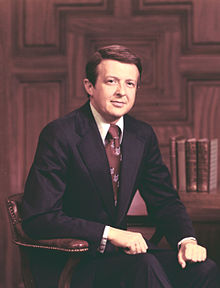James Holshouser
James Holshouser | |
|---|---|
 | |
| 68th Governor of North Carolina | |
| In office January 5, 1973 – January 8, 1977 | |
| Lieutenant | Jim Hunt |
| Preceded by | Robert Scott |
| Succeeded by | Jim Hunt |
| Member of the North Carolina House of Representatives | |
| In office 1963–1973 | |
| Chairman of the North Carolina Republican Party | |
| In office 1966–1972 | |
| Personal details | |
| Born | James Eubert Holshouser, Jr. October 8, 1934 Boone, North Carolina |
| Died | June 17, 2013 (aged 78) Pinehurst, North Carolina |
| Political party | Republican |
| Spouse | Patricia Ann Hollingsworth |
| Alma mater | Davidson College University of North Carolina, Chapel Hill |
James Eubert Holshouser, Jr. (October 8, 1934 – June 17, 2013) was the 68th Governor of the state of North Carolina from 1973 to 1977. He was the first Republican candidate to be elected as governor since 1896, when Republican Daniel L. Russell was elected as a Fusionist candidate. Holshouser's election reflected the new political realignment of the South, in which former white Conservative Democrats shifted to the Republican Party. By the end of the 20th century, the Republican Party was firmly based in the South among whites.
Life and career
Holshouser was born in Boone, North Carolina in 1934 and was the son of James E. "Peck" Holshouser, who was United States Attorney in the middle district of North Carolina under President Dwight Eisenhower.[1]
In 1962, two years after graduating from the University of North Carolina School of Law,[1] Holshouser was elected to the first of several terms representing Watauga County in the North Carolina General Assembly. This had been virtually a one-party, Democratic-dominated state since disfranchisement of blacks in 1899. During the 1960s, however, the Republican Party began to attract southern voters. Holshouser rose to the position of House Minority Leader.
He chaired the state Republican Party from 1966 through 1972, following passage of federal civil rights legislation in 1964 and 1965 that ended segregation and authorized federal oversight and enforcement of suffrage for African Americans.
In 1972, Holshouser defeated Jim Gardner for the Republican nomination for Governor, and then defeated Democrat Skipper Bowles in the general election, becoming North Carolina's first Republican governor elected since 1896. He was likely the beneficiary of coattails from Richard Nixon, who carried North Carolina and 48 other states in the Presidential election on the same ticket. At age 38, Holshouser was also the state's youngest governor since the nineteenth century.[1]
Many Republicans disliked Holshouser's moderate stances on issues. The governor supported Gerald Ford for president in 1976, while Republican U.S. Senator Jesse Helms (a former Democrat) supported Ronald Reagan. When Reagan won the North Carolina presidential preference primary of 1976, the Republican state convention refused to appoint Holshouser as a delegate to the Republican National Convention.[1]
His accomplishments in office included consolidation of the University of North Carolina system under a Board of Governors, capital improvement funding for the community college system, statewide enrollment for children in kindergarten, and establishment of health clinics in rural areas not served by local physicians.
After leaving office, Holshouser returned to the practice of law (at one point forming a firm with former Democratic Gov. Terry Sanford),[1] was elected to the Board of Governors of the University of North Carolina, and later served as a member emeritus. He also served on the Boards of St. Andrews Presbyterian College in Laurinburg, NC, and his undergraduate alma mater, Davidson College.
Holshouser eventually became great friends with Democratic Governor Jim Hunt, who had served as Lieutenant Governor under him. Holshouser was the last governor who was not eligible for a second four-year term; Hunt was elected in 1976 to succeed him. They served together on the North Carolina Advisory Board of DonorsChoose. Late in life, Holshouser campaigned alongside Hunt for state-funded judicial elections.[2]
He died on the morning of June 17, 2013.[3]
Legacy and honors
- Holshouser Hall, a residence hall at the University of North Carolina at Charlotte, is named in his honor.
- A stretch of US 321 between Boone and Blowing Rock is named for him.
- Professorships were endowed in his honor at both Appalachian State University and the University of North Carolina at Chapel Hill.[4]
- Holshouser was honored with the North Carolina Award in 2006; it is the state's highest civilian honor. [5]
References
- ^ a b c d e f Christensen, Rob. "Jim Holshouser, former North Carolina governor, dies at 78."
- ^ "Opinion: Our Views - Public Funding of Judicial Races Works", Rocky Mount Telegram
- ^ WRAL.com
- ^ "Governor McCrory Offers Condolences to Family of Governor Holshouser", Governor's Office
- ^ GOVERNOR AND FIRST LADY PRESENT STATE’S HIGHEST CIVILIAN HONOR TO SEVEN DISTINGUISHED NORTH CAROLINIANS
External links
- James Holshouser entry at the National Governors Association
- Biographical Timeline
- Oral History Interviews with James E. Holshouser Jr. [1], [2], [3], [4] from Oral Histories of the American South, Documenting the American South, University of North Carolina

